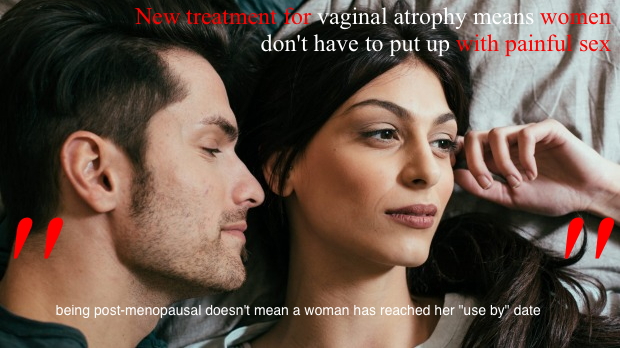Excerpt taken from The Sydney Morning Herald

In my sex-therapy practice, I see many women who suffer from painful intercourse, which makes it difficult – or sometimes almost impossible – to have a satisfying sex life. One reason can be vaginal atrophy, an uncomfortable condition many Australian women experience.
Vaginal atrophy causes changes in the structure and function of the vagina. It is often caused by hormonal changes associated with menopause, but may also occur in women who experience decreased oestrogen production such as after cancer treatment (chemotherapy or radiotherapy), surgical removal of ovaries, forced menopause or breastfeeding.
The drop in hormone levels can result in a thinning and loss of elasticity of the vaginal skin. The blood supply is reduced, the vagina loses much of its natural lubrication and there are changes in the natural pH balance of the area. This can cause symptoms such as vaginal itching, burning, thrush-like-symptoms and dryness, urinary incontinence, bladder urgency, laxity and prolapse. Not surprisingly, all these symptoms can have a negative effect on a woman’s wellbeing, self-esteem and intimate relationships.
In the past, treatment options for vaginal atrophy consisted mainly of ongoing application of oestrogen creams directly into the vagina. However many women who have experienced breast cancer, or have a history of abnormal blood clotting or other conditions, are not able to use hormone-replacement products. Others are uncomfortable about hormone replacement after so much negative press over the years.
New laser treatments counteract vaginal atrophy with a small laser that promotes blood flow to the region and encourages cells to promote more collagen, restoring the vaginal mucosa and rehydrating the vaginal walls. This results in more lubrication, tightness and elasticity in the vagina.
The laser treatment for vaginal atrophy is a simple procedure with minimal discomfort, suitable for almost all women, and involves little interruption from normal activities. It can be done in lunchtime. Initially, three treatments (lasting about 10 to 15 minutes each) a month apart are required. Some women experience an improvement after only one treatment. Top-up treatments might be necessary at yearly or less intervals.
As the procedure is relatively new in Australia, it’s not cheap and not covered by Medicare yet.
Both a client of mine and a friend have had the procedure for different reasons and are extremely happy with the results. My client, who is in her late 30s, had breast cancer and experienced all the symptoms of menopause. She tried the procedure because she could not take hormone replacement and after two months, she was able to have sex without pain. Her partner was very pleased, as they had stopped intercourse because he did not want to hurt her. It was just too painful and uncomfortable, but now they are over the moon.
Research shows that about half of all Australian women will suffer some of these symptoms in their lifetimes, but apparently not everyone tells their doctor. It’s time to destigmatise the condition –being post-menopausal doesn’t mean a woman has reached her “use by” date.
Just like men who suffer from sexual dysfunction, women should feel entitled to take steps to improve their sex lives.
Article written by Matty Silver
Originally published by The Sydney Morning Herald

